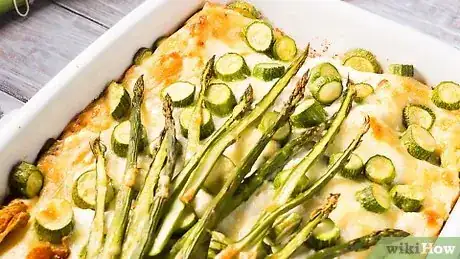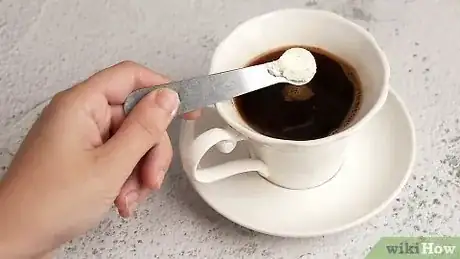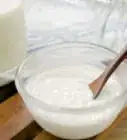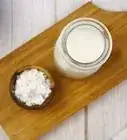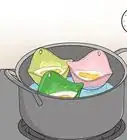This article was co-authored by wikiHow staff writer, Jessica Gibson. Jessica Gibson is a Writer and Editor who's been with wikiHow since 2014. After completing a year of art studies at the Emily Carr University in Vancouver, she graduated from Columbia College with a BA in History. Jessica also completed an MA in History from The University of Oregon in 2013.
There are 8 references cited in this article, which can be found at the bottom of the page.
The wikiHow Culinary Team also followed the article's instructions and verified that they work.
This article has been viewed 51,565 times.
Learn more...
So, what is powdered buttermilk? Powdered buttermilk is simply liquid buttermilk that's been concentrated and evaporated to turn it into powder. If you bought powdered buttermilk for a recipe and aren't sure what to do with the rest package, prepare to be pleasantly surprised! Not only can you use powdered buttermilk to replace liquid buttermilk when baking, but you can also add the powder straight to a variety of foods. Keep reading for delicious suggestions and helpful storage tips.
Things You Should Know
- If you're baking with powdered buttermilk, add the powder to the dry ingredients and add extra water to the wet ingredients of your recipe.
- You can use powdered buttermilk like a seasoning and add it directly to food that you'd like to give a tangy, creamy taste.
- Store unopened powdered buttermilk in the pantry for up to 10 years. Once you open the powdered buttermilk, keep it in the fridge and use it within 4 to 5 days.
Steps
Baking with Powdered Buttermilk
-
1Substitute powdered buttermilk in recipes that call for liquid buttermilk. Powdered buttermilk is convenient and it reacts with other ingredients in your recipe, particularly baking soda, to make baked goods that are tender and light. If you're looking for a way to bake with powdered buttermilk, try it in:
-
2Mix powdered buttermilk into the dry ingredients of your recipe. Check the label of your powdered buttermilk to see how much you need to add—in general, you usually add 1/4 cup (30 g) of powdered buttermilk for every 1 cup (240 ml) of buttermilk that's called for in the recipe. Mix it into the dried ingredients like flour and sugar.[1]
- If you'd like to reconstitute the powdered buttermilk in liquid before adding it to something like a glaze for your baked goods, whisk 1 tablespoon (7 g) of powdered buttermilk into every 1⁄4 cup (59 ml) of liquid for the glaze.
Advertisement -
3Add additional water to the wet ingredients of your recipe. Plan on adding 1 cup (240 ml) of water for every 1/4 cup (30 g) of powdered buttermilk you use. Whisk the extra water into the wet ingredients like the milk and eggs before proceeding with your recipe.[2]
- Adjust these amounts if your recipe calls for more or less buttermilk, but keep the ratio of powdered buttermilk to extra liquid at 1 part to 4 parts.[3]
-
4Follow the recipe's baking instructions. You don't need to adjust the baking time when you substitute powdered buttermilk for liquid. As long as you've added extra liquid to the recipe along with your powdered buttermilk, it will turn out great! Follow your recipe's directions for setting the oven temperature and baking time.
Adding Powdered Buttermilk to Recipes
-
1Sprinkle powdered buttermilk on popcorn you've popped. If you want popcorn that bursts with flavor, mix a spoonful of powdered buttermilk with a dash of salt and onion powder before you sprinkle it on your freshly popped popcorn.[4]
- Powdered buttermilk or the salty-onion buttermilk mix also taste great when you sprinkle them on your favorite chips or crackers—try it on buttered saltine crackers for a snack you can't put down!
-
2Mix powdered buttermilk into creamy dipping sauces. If you want to add a tart flavor to a dipping sauce without thinning it down, whisk a spoonful of powdered buttermilk directly into your dip or sauce. Try it when you make ranch dressing, creamy veggie dips, or creamy caesar dressing.[5]
- Add a sprinkling of powdered buttermilk to storebought dip like sour cream and onion flavor. The powdered buttermilk really amplifies the flavor and makes it taste homemade.
- Make a quick sandwich spread by whisking 1 tablespoon (15 ml) of buttermilk powder into 1 cup (230 g) of mayonnaise.
-
3Add a dash of powdered buttermilk to casseroles and quiches. Whisk a tablespoon or two of powdered buttermilk to the liquid before you bake your casserole or whip up a quiche. If you're adding meat like chicken to your casserole or quiche, the powdered buttermilk will also make it more tender.[6]
- Mix a dash of buttermilk powder into creamy soup or gravy anytime you want a greater depth of flavor without thinning the food.
-
4Reconstitute buttermilk powder to use in a marinade for chicken. Buttermilk is naturally acidic, so it tenderizes chicken—no more tough or overdone meat! Reconstitute around 2 cups (470 ml) of buttermilk, but use 25% less water when you mix it with the powder so it's not too thin. Marinate your chicken breasts or tenders in the buttermilk for 10 to 20 minutes. Then, bake or fry the chicken any way you like.[7]
- Feel free to add seasonings to the buttermilk marinade. Try chopped chives, dried garlic powder, or a squirt of hot sauce for a little kick.
- Avoid marinating the chicken in the buttermilk for more than 1 hour because the acid in the buttermilk will cause the chicken to break down.
-
5Add powdered buttermilk to mashed potatoes. Mashed potatoes can be a little bland, but a little powdered buttermilk lends a rich, tangy flavor. Dissolve a few spoonfuls of powdered buttermilk in about 1 cup (240 ml) of warm water or milk and use this liquid to make mashed potatoes any way you like.[8]
- Taste the mashed potatoes and add more powdered buttermilk until the flavor is to your liking.
-
6Stir powdered buttermilk into your coffee in place of creamer. Whisk about half of a spoonful of powdered buttermilk into hot coffee until it dissolves—feel free to add more until the coffee is as creamy as you like. The powdered buttermilk adds a bright flavor that's great with light roasts or breakfast blends. It also adds protein to your coffee, so it's a great way to start the day![9]
- If you enjoy flavored creamer, add a few drops of vanilla extract and a spoonful of sugar when you add the powdered buttermilk to your coffee.
-
7Add powdered buttermilk to glaze and frosting. Sweet desserts pair really well with a little buttermilk. Whisk a small spoonful of buttermilk powder into glaze or frosting when you add the liquid called for in your recipe. The zippy flavor of the buttermilk cuts some of the sweetness and adds a little interest to the treat.[10]
- Try this when you glaze fruit scones or tarts. It's also delicious in frosting for vanilla cake or sugar cookies.
Storing Powdered Buttermilk
-
1Store unopened powdered buttermilk in the pantry for 2 to 10 years. Powdered buttermilk is incredibly shelf stable, especially if you store it in a cool dry place. The length of time you can keep it unopened in the pantry depends on its original packaging—store powdered buttermilk that comes in a non-airtight package for up to 2 years or store powdered buttermilk that comes in an airtight container for up to 10 years beyond the best-by-date.[11]
- If you don't want powdered buttermilk taking up valuable pantry space, put it into a bag and vacuum seal it. Then, stick it in the freezer and use it within 10 years of the best-by-date.
-
2Keep opened powdered buttermilk in the fridge and use it within 4 to 5 days. If your package of powdered buttermilk is resealable, great! If not, transfer the powdered buttermilk to an airtight container and stick it in the fridge. It does start to degrade quickly after opening the package, so plan on using it quickly.[12]
- It's a good idea to label the package with the date you opened it—that way you know you need to use it within 4 to 5 days of that date.
-
3Throw out powdered buttermilk if it's discolored or smells bad. If you didn't label powdered buttermilk when you opened it, or you're unsure if a new package that's past its sell-by-date is still good, open it and check it out. Discard the powdered buttermilk if it looks yellow or smells really sour—these are signs that the buttermilk has gone bad.[13]
- Don't be tempted to bake with the questionable powdered buttermilk. If you're really in a pinch, substitute yogurt for the buttermilk or sour a little milk to use in your baking recipe.
References
- ↑ https://www.americastestkitchen.com/articles/5524-powdered-buttermilk-is-a-lifesaver
- ↑ https://www.americastestkitchen.com/articles/5524-powdered-buttermilk-is-a-lifesaver
- ↑ https://www.gourmetsleuth.com/ingredients/detail/buttermilk-powder
- ↑ http://www.thekitchn.com/powdered-buttermilk-is-the-better-alternative-to-wasted-buttermilk-231822
- ↑ http://www.thekitchn.com/powdered-buttermilk-is-the-better-alternative-to-wasted-buttermilk-231822
- ↑ https://www.happypreppers.com/buttermilk.html
- ↑ https://www.thekitchn.com/recipe-double-crusted-chicken-tenders-with-sriracha-honey-bbq-sauce-231519
- ↑ https://www.food.com/recipe/zaarite-doctored-up-fake-mashed-potatoes-199494
- ↑ https://www.happypreppers.com/buttermilk.html
- ↑ https://aweekendcook.com/how-to-use-buttermilk-powder/
- ↑ http://www.eatbydate.com/dairy/milk/how-long-does-powdered-milk-last-shelf-life/
- ↑ http://www.eatbydate.com/dairy/milk/how-long-does-powdered-milk-last-shelf-life/
- ↑ http://www.eatbydate.com/dairy/milk/how-long-does-powdered-milk-last-shelf-life/
About This Article
To bake with powdered buttermilk, combine 1/4 cup of the powder with 1 cup of water to replace 1 cup of liquid buttermilk. Mix in the buttermilk with the eggs and other wet ingredients if the recipe calls for it, or mix dry buttermilk with the flour instead. To use dry buttermilk to add flavor, try sprinkling it over popcorn or mixing it into creamy dipping sauces. You could also consider adding some powdered buttermilk to a quiche. For tips on how to store powdered buttermilk, including when you should throw it out, read on!


